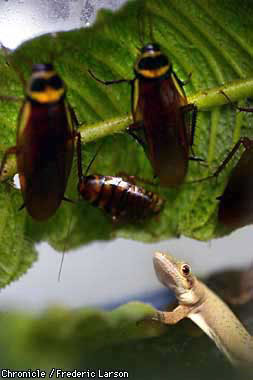Checkout Time for
Roaches
Conservatory's bug blight turned over to hungry
geckos
Glen Martin, Chronicle Staff
Writer
It's one of those stories that should be an
urban myth but is all too nauseatingly true -- a story
simultaneously involving a place of great beauty, a storybook
wedding and the most disgusting bug on the planet.
And there's a kicker: salvation in the
guise of a lizard.
Just before the San Francisco Conservatory
of Flowers closed five years ago, a wedding party was held in its
humid interior. The bride and groom were married in one room of the
giant hothouse, while the wedding cake was displayed in another.
Once the nuptials were completed, the party
repaired to the adjoining room to cut the cake -- a cake covered
with giant Australian cockroaches, as it turned out.
The bride screamed and ran from the
conservatory in tears.
At that point, said Sherri Ferris, a board
member of the Friends of Recreation and Parks, a San Francisco group
devoted to raising money for civic works, it became apparent that
the conservatory required some serious bug control mojo.
Things have been put on hold for the past
five years while the 122- year-old building -- heavily damaged
during a 1995 wind storm -- has been undergoing repairs.
The Friends of Recreation and Parks have
raised about two-thirds of the $18 million needed for renovation,
and estimate the conservatory will reopen in 2003.
THICK WITH FLEAS, ER, ROACHES
But the cockroaches are still there by the
teeming and stomach- turning multitudes, fat, sassy and noxious as
ever. And they can't be controlled by potent insecticides -- a
terrible environmental faux pas by San Francisco standards.
The solution: geckos. Sticky-footed lizards
that prowl the interiors of houses for bugs, occasionally pausing to
peep timorously or lick their own eyeballs.
About twenty geckos will be turned loose
today, and more will be released at some later date. A few anoles --
small lizards that change color like chameleons -- also will be set
free.
There are scores of species of geckos.
Though they are found in temperate areas, they are particularly
common in the tropics and desert regions. They vary widely in size
and coloration, but all share a common characteristic: voracious
appetite.
Australian cockroaches are haute cuisine to
geckos. For a bug, they're big and meaty -- but they're also quite
tender, with relatively soft exoskeletons. To a gecko, they're as
succulent as poached salmon.
Not that the geckos don't have their work
cut out for them. Many of the lizards scheduled for today's release
are immature -- scarcely bigger than the roaches they're supposed to
tackle.
``We hope they can eat the (roach) eggs and
babies until they get bigger,'' said P.J. Jamison, a Friends of
Recreation and Parks board member.
LIZARDS NOT PICKY
But prey size isn't much of an intimidation
factor to the average gecko, observed Julie Bergman, the owner of
The Gecko Ranch in Davis.
`If they can fit it into their mouths,
they'll try to eat it,'' Bergman said.
Cockroaches, in short, should prepare to
shiver in their chitin with fear.
Bergman raises 55 species of geckos, and
she provided the Friends of Recreation and Parks with three
varieties -- lined day geckos, dull day geckos and house geckos --
to deal with the roach problem.
All are tropical geckos, meaning they're
unlikely to spread throughout Golden Gate Park in the event of an
escape. But they'll reproduce readily in the warm, moist environment
of the conservatory, said Bergman.
``Several of the females I gave to the
conservatory were gravid (full of fertilized eggs),'' Bergman said.
Cockroaches are common through San
Francisco, of course, but the ones seen in most city kitchens are
German cockroaches. They're small and relatively inconspicuous.
ALL THIS, AND THEY FLY
But the Australian roaches are much bigger
-- some would say uglier as well. And unlike German roaches, they
fly readily.
As far as anyone knows, the Conservatory of
Flowers is the only place in the city that harbors the bugs.
Conservatory gardeners say they probably hitchhiked in on imported
plants.
In a less enlightened past, the
conservatory would be tented and gassed with a chemical strong
enough to peel paint, let alone kill cockroaches.
But the gecko project demonstrates that San
Francisco has moved away from such heavy-handed and environmentally
dangerous practices. Integrated pest management (IPM) is now the
standard way of dealing with insects and weeds on city property.
IPM relies on plant monitoring for
infestations, predatory insects and animals and the restricted use
of pesticides and herbicides. When some kind of chemical agent is
unavoidable, only the least deleterious substances are used.
Deborah Raphael, the pesticide program
coordinator for the San Francisco Department of the Environment,
says IPM is now used in city parks, golf courses and buildings.
SENSITIVE, MAKES SENSE
Raphael said IPM has allowed staffers to
cut pesticide use in San Francisco by 50 percent, ``and the
pesticides we do use are very low risk,'' she said.
``We're using goats to control weeds at
Hetch Hetchy Reservoir, flame torches to destroy young weeds in
Golden Gate Park and corn gluten meal instead of herbicides to
suppress weeds at (San Francisco International) airport,'' Raphael
said, ``so this project is right in keeping with our general
program.''
Raphael said low-toxicity baits are usually
employed for German cockroaches, but added the Australian roach
isn't very susceptible to baiting.
``This is a pretty tough roach,'' she said.
``Geckos offer an exotic solution to an exotic pest.''
|
